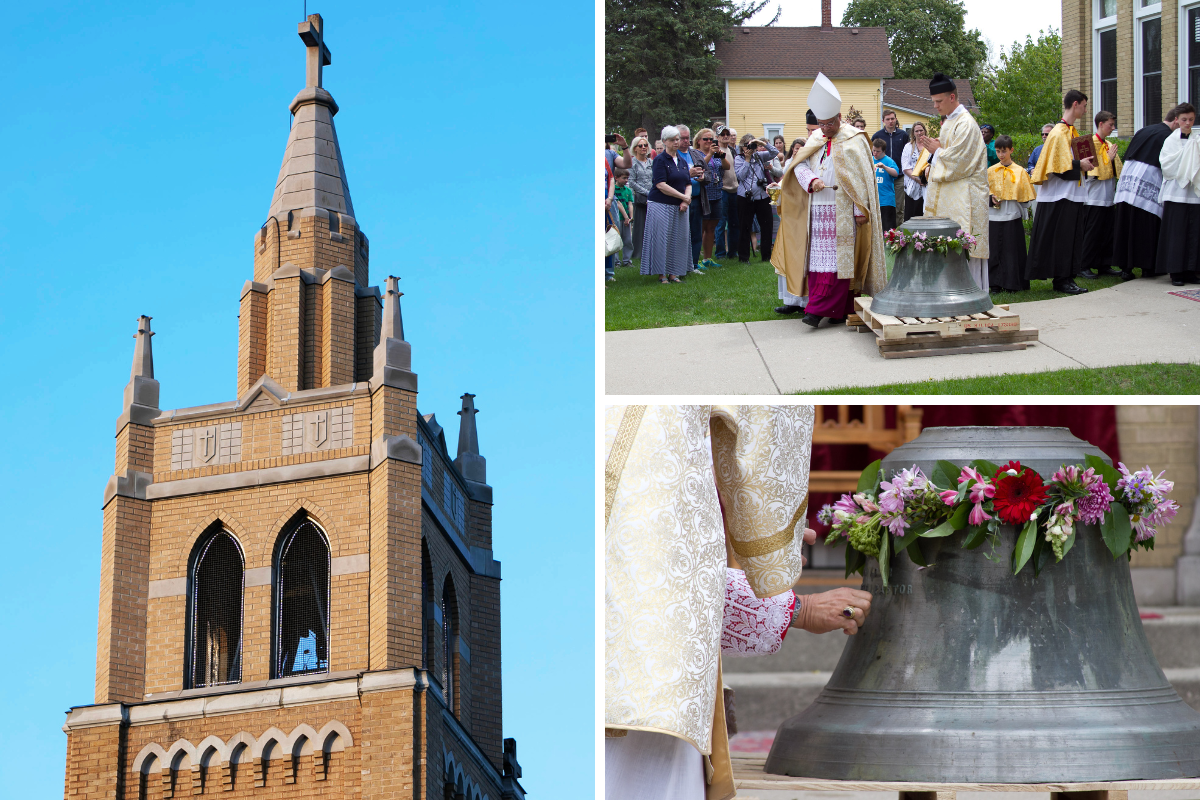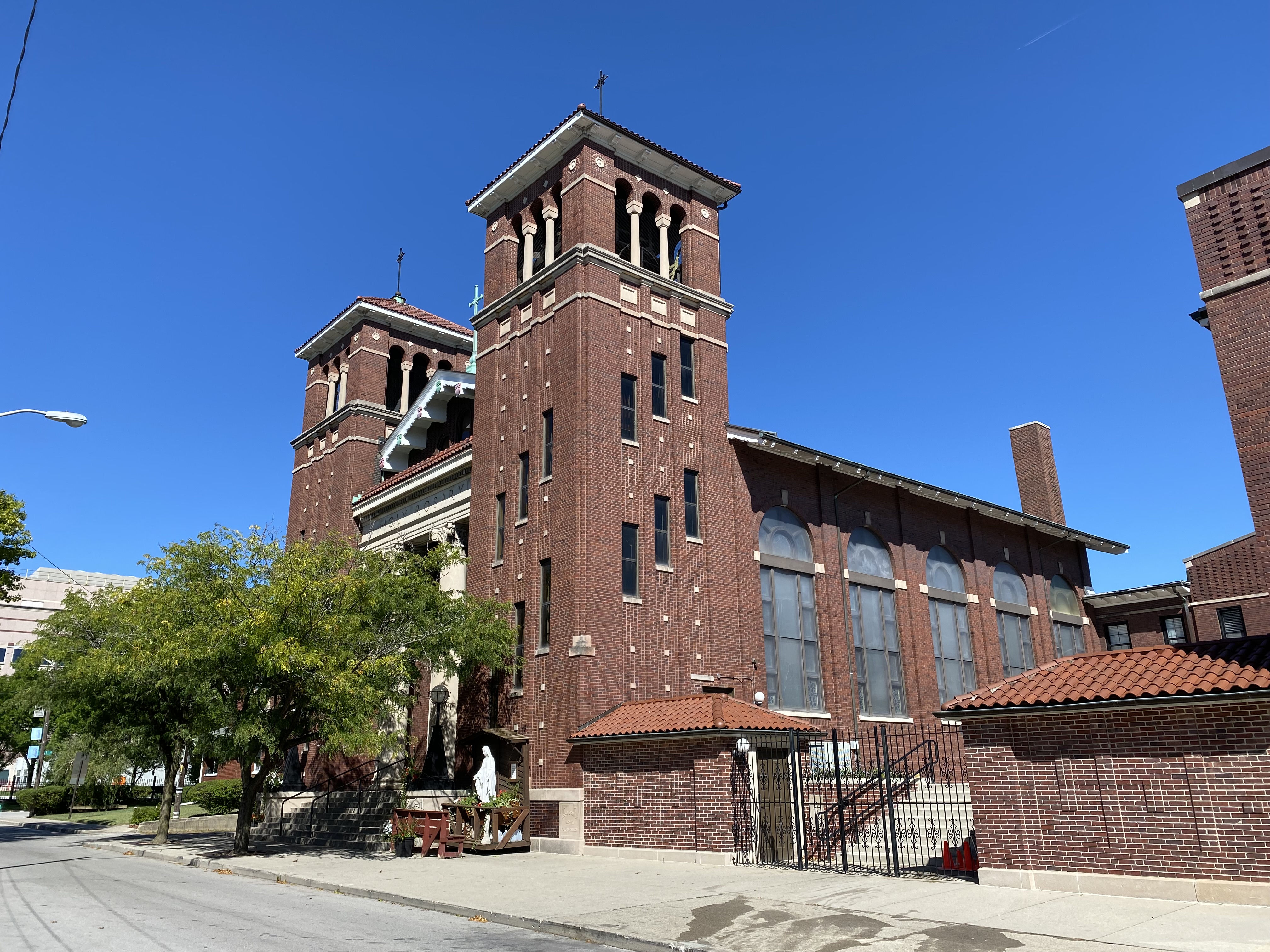‘Sanctified Sound’: The Return of Bell-Tower Bells Ringing at Eucharistic Consecration
Joyful pealing during Mass tells world, ‘We believe in Jesus Christ.’

Ringing the handheld Sanctus bells during the consecration and elevation of the Host and chalice at Mass is a familiar sound in many churches. Yet another centuries-old practice has remained in some places and has returned in others: ringing the bells in the church’s bell tower at the Consecration.
At St. Peter Catholic Church in Volo, Illinois, shortly after its unstable bell tower was restored in 2018, the ringing tradition was revived. Before that, the 1925 bell had been removed and placed on a pedestal in front of the church as a monument. Today’s pastor, Father Nathan Caswell of the Canons Regular of St. John Cantius, who was associate pastor at the time, took part in the 2018 reconsecrating of the bell done by Chicago Auxiliary Bishop Joseph Perry, who named the bell “Margarita.”

“It looks like a baptism in some sense. It’s baptized, and chrism is put on the bell because this is an instrument of proclaiming the glory of God,” Father Caswell told the Register. “So the sound of the holy bell is a sanctified sound. It’s something set apart.” Now, the bell rings out during the Consecration at Sunday Masses and holy days of obligation. The bell is joined by the Sanctus bells in the sanctuary. Father Caswell explained that ringing the bell in the steeple during the Mass “is to signal the importance of the Consecration — that Christ has become present on the altar — and it proclaims the glory of God to the world outside.”
“That image of the call to prayer during the Consecration, the idea of pealing the bells during the Consecration, is really a call to vigilance and focus to see the most essential part of the Mass going on, the Institution narrative and the Eucharistic Prayers,” explained Father Spencer Howe, pastor of Holy Cross Catholic Church, in northeast Minneapolis. At the elevation of the Host and of the chalice, the tradition of the Sanctus bells draws people's attention, but “the tradition of the tower bells really draws their attention,” he emphasized.
“We don’t want to keep the faith all to ourselves,” Father Howe said. “We really want to announce to the neighborhood that the mystery of faith is present on the altar. We want to share that with those who are around us. It really is a proclamation of that exuberance and fullness to let the world know that we have a reason to celebrate.”
His church rings the five bells in the bell tower during the Consecration at the midnight Mass on Christmas Eve as well as during the Easter vigil. More recently, they have rung on the Solemnity of Corpus Christi and sometimes for 40 Hours devotion. As soon as the ailing electronic bell controller gets repaired or replaced, Father Howe hopes to start to ring them for Sunday Masses.
The tradition carries on far and wide. After being silenced for more than 10 years, the bells in the tower of St. Francis Catholic Church, a small rural parish in Thermopolis, Wyoming, began ringing again for this past Christmas Eve vigil Mass. In this case, the parish raised the funds for a new digital bell system with speakers in the tower to daily call “the faithful to prayer with the Angelus at noon and also add to the beauty of our liturgy, ringing during the Consecration at Mass,” Adam Estenson, vice president of the pastoral council, told the Register. “Their rich, sacred tones elevate the spiritual experience, connecting our parish to the deep traditions of the Church,” he said, describing it as “a profound blessing” uniting the community and “enriching our worship.”
Estenson, who is also mayor of the town, attends Mass with his wife and children and with this new system easily rings these bells during the Consecration from his place in the pew. His duty rotates with others.
Back in Illinois, at St. Peter Church, head altar server Joshua Masterson, who creates cartoons as “The Catholic Cartoonist,” teaches the altar-serving crew how to serve and instructs them in the “exciting privilege” of how to ring the church’s bell at the Consecration, by pressing a particular button on a small remote that activates the bell tower for the five Masses on Sundays and holy day Masses.
From his experience, Masterson hopes all parishes use tower bells during the Mass. “The sound of the bells brings our attention to the Eucharistic King,” he said. “They announce to all, ‘He dwells among us!’ (John 1:14).”
At Our Lady of the Most Holy Rosary Catholic Church in Indianapolis, five smaller bells in the east tower and the large bell in the west tower are now motorized and also remote-controlled. One server rings them during the Consecration while the others also add the small Sanctus bells. The tradition of ringing the tower bells during the Consecration and elevation was revived in this church in 1998, explained David Walden, the director of communications, when the archdiocese moved the traditional Latin Mass here. At that time, he said the 7,000-pound “San Salvador,” the largest free-swinging bell in the state, was still operated by rope, and he himself rang it.

The Abbey of Regina Laudis in Bethlehem, Connecticut, has one large consecration bell suspended in its tower that is always rung manually during “the Consecration of the bread through the Consecration of the wine without interruption,” the abbey related via email to the Register, because “its meaning in the Mass signifies that Transubstantiation is taking place: The Body and Blood of Christ are on the altar.” The bell is rung whether the priest offers the Mass in Latin or English.
According to the abbey, when foundress Mother Benedict Duss came from the Abbey of Notre Dame de Jouarre in the Diocese of Meaux in France, she “brought the traditions of both the Benedictine Order and the French Catholic culture of Paris and its environs.
“In both traditions, ringing of bells, including the consecration bell, has been common practice for centuries and continues today.”
Resounding History
The use of holy bells traces to Exodus, with instructions that high priest Aaron’s garments must include bells of gold around the lower hem of his robe so that when he entered the holy places their sound would be heard. And Sirach repeats that Aaron was to wear a garment “with many golden bells all around, to send forth a sound as he walked, to make their ringing heard in the temple as a reminder to his people.” And as Psalm 98:4 declares, “Make a joyful noise to the Lord, all the earth.”
Historic records show that at Old St. Peter’s in Rome, Pope Stephen II (752-757) erected a belfry with three bells. Then, during the eighth century, bell towers and the use of bells became widespread and were considered an essential part of every church. At the same time, blessing them by a special form of consecration and naming them became widespread.
At first, the bells announced the time of church services because people did not have clocks. Then, by the beginning of the 13th century, it became the custom to ring the tower bell or bells when the sacred Host was elevated at Mass. This alerted people working in the fields and elsewhere, and those sick or unable to attend Mass, to momentarily kneel (if they were able) and make an act of adoration.
Peal of Approval
Those attending Mass at Regina Laudis are always appreciative of their customs, according to the abbey. “Cardinal John Henry Newman underlined the fact that Benedictine monasteries have often been built on hilltops so that the faithful lift themselves up to God, and so that prayers and sounds (bells) emanating from bell towers on the hilltops, can more easily spread to neighboring towns.” At the same time, “relationships with neighbors are in fact strengthened when they synchronize the abbey’s bells with some personal or family activity.”
At Holy Cross in Minneapolis, Father Howe finds it “a way that we share with the broader world and neighborhood around us that Christ is here.” He sees it as “a reminder that what goes on in the church, even though it’s mysterious, is important for everyone.”
Mentioning that the church is located in an urban, arts quarter in the city, he knows “that people who live in the neighborhood, especially people who are secular, are really comforted by the sound of bells, and that it’s part of the tradition of our neighborhood to have these bells that are living reminders that these churches are not just museums. They’re not just beautiful brick buildings, but they’re really living edifices of prayer.”
Walden, who has been at Most Holy Rosary Church 27 years, remembers that at first the neighbors did not like the frequent bell-ringing. “But now it’s been years since anyone has complained. The parishioners and many in the neighborhood absolutely love the sound of our bells. That’s all we hear now. A lot of parishioners have moved into the neighborhood.”
In Wyoming, Estenson has only heard from “people that love it. It brings a traditional feel to that moment. It’s been very well-received in our parish.” In fact, with all the positive reactions and added sanctity, he unhesitatingly reported, “We hope it can inspire other parishes to embrace the timeless beauty of church bells and the spirit of community that makes such efforts possible.”
Citing St. Peter’s growth, with many new families and weekly registrations for the last five years, Father Caswell mentioned a similar purpose with ringing of the consecration bells. “It’s just like when you have a procession,” he explained. “You go out, and there’s a proclamation of the faith that you’re standing in front of the world and saying, ‘I believe in Jesus Christ.’ The bell ringing outside is similar. It is to say to the world, ‘We believe in Jesus Christ.’ It is proclaiming the Gospel, but the effect it has on us is significant.”
- Keywords:
- catholic traditions
- bells
- smells and bells

















